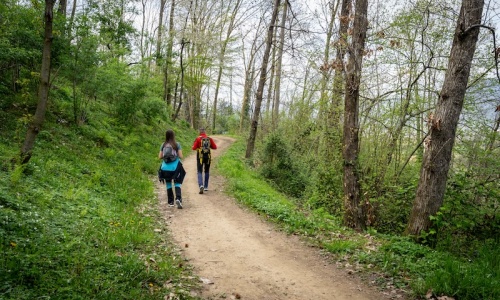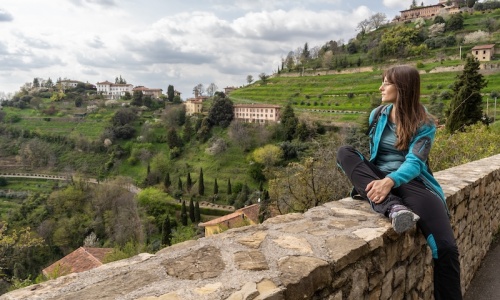This moderately long but easy route takes you on a discovery of the "vasi," the settling tanks for water, installed along the ancient aqueduct which dates back to the 11th century. The itinerary winds its way up to the San Vigilio hill via scenic roads, woods, and paths, offering a peaceful walk immersed in the nature and history of Bergamo.

Starting from Largo Colle Aperto, which is reachable by bus No. 1 (final stop), take a moment to admire the panoramic view before heading down Via Beltrami. This path allows you to leave the city’s hustle behind and enter the majestic greenery of the surrounding hills. At the junction in front of the Church of S. Rocco, turn left toward Gallina, at the 1.7 km mark. From here, take Via Castagneta, a cobbled path marked by a sign for Trail No. 912, the Via dei Vasi.
Starting from Largo Colle Aperto, which is reachable by bus No. 1 (final stop), take a moment to admire the panoramic view before heading down Via Beltrami. This path allows you to leave the city’s hustle behind and enter the majestic greenery of the surrounding hills. At the junction in front of the Church of S. Rocco, turn left toward Gallina, at the 1.7 km mark. From here, take Via Castagneta, a cobbled path marked by a sign for Trail No. 912, the Via dei Vasi.

The trail flattens out as it enters the woods, surrounded by vegetation and small streams that make you forget you are near the city. If you look closely, you may spot some "uschioli," small stone-framed openings that were used to inspect the water tanks. At the 3 km mark, there is a rest area with benches near a small stream, where you can take a break. Continuing for another 1,500 meters, you will reach the final staircase, along which you will find the Sorgente della Noce, a spring that supplied water to the ancient aqueduct.
The trail flattens out as it enters the woods, surrounded by vegetation and small streams that make you forget you are near the city. If you look closely, you may spot some "uschioli," small stone-framed openings that were used to inspect the water tanks. At the 3 km mark, there is a rest area with benches near a small stream, where you can take a break. Continuing for another 1,500 meters, you will reach the final staircase, along which you will find the Sorgente della Noce, a spring that supplied water to the ancient aqueduct.

At the end of the staircase, turn left onto Via Ramera, a paved road that soon turns into a cobbled uphill path. After joining Via Scalvini, keep right on Via Vetta, then take the ancient path of Via Monte Bastia to the left. This is an ideal spot to enjoy panoramic views of the entire Alpine arc. Continue to the end of Via Monte Bastia, then turn right onto Via San Vigilio. Along this road, you will come across the church, the castle, and finally the San Vigilio funicular. The journey of discovering the ancient aqueduct ends as you continue toward the views of the bell towers of Città Alta, descending toward Porta S. Alessandro, and finally reconnecting with Colle Aperto.
At the end of the staircase, turn left onto Via Ramera, a paved road that soon turns into a cobbled uphill path. After joining Via Scalvini, keep right on Via Vetta, then take the ancient path of Via Monte Bastia to the left. This is an ideal spot to enjoy panoramic views of the entire Alpine arc. Continue to the end of Via Monte Bastia, then turn right onto Via San Vigilio. Along this road, you will come across the church, the castle, and finally the San Vigilio funicular. The journey of discovering the ancient aqueduct ends as you continue toward the views of the bell towers of Città Alta, descending toward Porta S. Alessandro, and finally reconnecting with Colle Aperto.